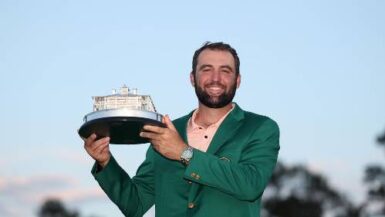The epic war between Greece and Troy was poignantly summed up by Homer in one powerful line of The Iliad: “For ten years they battled beneath the city walls, and no one knew whose side the Gods were on.”
The greatest week in golf arrives with similar confusion and uncertainty, but also with an inspiring milestone. Though the PGA Tour lacks a dominant player for the first time in 13 years, and a potpourri of foreign players are surging past their American counterparts in the world rankings, the Masters endures and celebrates the 25th anniversary of Jack Nicklaus’s miraculous Sunday charge to victory in 1986, arguably professional golf’s greatest day. This year, golf’s annual rite of spring – already the most stately, refined, and charming event in sports – has an added dimension of regalia and nostalgia.
Golf needs the excitement right now. Until Phil Mickelson finally shook off the rust last weekend with a 63-65 finish in Houston, the first quarter of the golf season was as exciting as cottage cheese and celery. None of the game’s marquis players – the so-called Big Five – were in contention for longer than a few holes at a time and the recent wave of “young guns” adorned as the next generation fizzled as well.
Phil, Vijay, Ernie, and Retief are showing their age. While they can still post the occasional sublime round, their consistency has wavered. Padraig Harrington looked to join that elite group after winning three majors in six starts, but he’s been lost for a year trying to work his way back from swing changes. Even Lee Westwood, who seems to contend at every major before fading down the stretch, has had a poor start to the 2011 season. With the exception of Mickelson, who finally got himself out of what looked to be a slump, none of golf’s household names has been the week-in and week-out factor that Ponte Vedra and Madison Avenue so desperately need.
Moreover, while this also looked to be the year Rickie Fowler, Anthony Kim, Dustin Johnson, Hunter Mahan, and Matt Kuchar all broke through to super-stardom, they all missed the starter’s gun. Instead we got Jonathan Byrd, Mark Wilson, D.A. Points and Gary Woodland in the PGA Tour winner’s circle and network broadcast booth. Most fans couldn’t pick them out of a line-up of Duke Ellington’s orchestra.
Then of course there’s Tiger.
Both the PGA Tour and the entire golf world are faced with the inconvenient truth that Tiger Woods – their runaway gravy train, for the last 13 years – is now one of 154. Once the dual revelations of sex scandals and links to shady steroid pushers decimated his aura of invincibility, Woods has become just another good golfer who makes endless headlines because of his celebrity and salacious reputation rather than his play on the course.
It just goes to show: No matter how much you try to fence yourself in, you can’t fence the rest of the World out.
Woods’s play has ranged from “merely pretty good” to “shockingly indifferent,” and hot-and-cold golf doesn’t win weekly tour stops, let alone majors. There is no question: Tiger’s accident, scandals, and humiliation took a permanent toll of his golf swing. Whatever you’re feeling, it travels right down the club to the ball. Golf balls know exactly what you’re thinking and do not care.
Golf balls are heartless that way.
Golf’s day of reckoning has arrived, as happens when you make the mistake of anointing one person “bigger than the game.” Woods no longer looms over the golf landscape like Godzilla licking his chops at a Tokyo slathered in teriyaki sauce. Indeed, the last time he was at Augusta, he got taken to the woodshed by Masters Tournament Chairman Billy Payne in a withering public tongue-lashing that served a critically important purpose – to remind us all that no one is bigger than the game and true golfers and champions put the game’s virtues before their egos. Most people quietly applauded Payne’s courage and candor, grateful that he delivered the sharp condemnation that should have come from Tim Finchem. Many whisper that he should be the next PGA Tour Commissioner. With his tireless devotion to the game’s unwavering moral compass, he’d be terrific.
Like everything else in life, golf is cyclical. In the late ’80’s and early ’90s, European players dominated the PGA Tour. Once again players from the U.K. and the continent are the dominant stars of golf. Paul Casey, Martin Kaymer, (pronounced KIGH-mur), Louis Oosthuizen, (pronounced LOO-ee WEST-hay-zin), and Luke Donald, have all won on the European Tour and England’s Nick Watney has won on both tours. Moreover, their young Bantam rooster, Spain’s Alviro Quiros has also won this year. For the moment, the balance of power in golf has shifted to Europe. 52 of the 96 players starting on Thursday morning are from outside the United States, a trend that has grown strongly over the last few years.
So as the Masters dawns, so too does a new age of parity in professional golf. Did you know that since 2001 45% of major championship winners, (18 out of 40), have, so far, been “one and done,” winning just one major? In chronological order, they were: David Duval, David Toms, Rich Beem, Mike Weir, Jim Furyk, Ben Curtis, Shaun Micheel, Todd Hamilton, Michael Campbell. I’ll let you come up for air and then add Geoff Ogilvy, Zach Johnson, Trevor Immelman, Lucas Glover, Stewart Cink, Y.E. Yang, Graeme MacDowell, Louis Oosthuizen, and Martin Kaymer.
And if Kenny Perry hadn’t forgotten to finish last year’s Masters both he and Angel Cabrera would be on that list, making it an even 50%.
Can any of these guys repeat ever? Let alone this week in the crucible of Sunday afternoon at Augusta? Maybe: Yang, MacDowell, and Kaymer are not only playing the most consistently right now, they have the most phlegmatic demeanors. Pressure, what pressure? Selfless workman-like overachievers like the foreign players may be even hungrier right now than their American counterparts, embracing, even relishing the challenge.
Yet despite all the cataclysmic change that will rock the PGA Tour now that they can’t rely on one man, all of golf can always rely on one tournament: The Masters.
“We still have something pure,” said ardent golf fan Ken Jokall. “We love The Masters because it symbolizes everything good about the game….It shows how high we all can reach together if we put aside our egos and our greed and focus on the purity of the sport.”
Indeed, in an age where society has capitulated to the reckless indifference of a libertine disposition, allowing greed to pervert the sports industry, only the Masters takes Alfred Lord Tennyson’s advice and stands apart in quiet dignity: stoic and sentinel amidst the chaos and traffic of the world, wisely stewarding and promoting the game’s altruistic virtues, like a lighthouse casting its sturdy beacon through a raging maelstrom.
Who has the edge this year at the Masters? The same player who has always had the edge at the Masters: The player who happens to have the best week putting, hitting greens in regulation, and recovering from trouble. Sure, long hitters have an advantage off the tee. But the Hank Haney-coached version of Tiger aside, all the length in the world doesn’t put the ball in the hole at Augusta.
Most of all, no major rewards experience more than the Masters. Consider this fact: there are fewer one-time major championship winners who won at the Masters than at any other major. The PGA Championship has thirty-two winners who claimed it as their only major, the U.S. Open has twenty-three, the British Open twenty-two, but the Masters a mere fourteen. At Augusta, the wider fairways, yet tiny second-shot targets, coupled with the ability to allow the players to recover from trouble, allow the best players to use their entire array of talents. They are not limited to hitting irons off the tee and wedges to the fairway after finding the rough. Additionally, the pressure at the Masters, the weight of history and the future of his career on his shoulders, may ultimately reward the more experienced player.
So like it has ever since the World fell in love with on it after the first televised golf broadcast, Augusta’s mesmerizing spell will once again enchant us, revitalize us, and inspire us. Augusta is beguiling greens that slope off in many different directions, sending balls scurrying into perdition. It’s towering loblollies, homespun wisteria vines, and radiant azaleas blooming hardily in defiance of the last vestiges of winter’s chill. It’s the withering stretch of 10-12 sending players into a tailspin, and it’s the razor’s edge of 13 and 15 waiting provide a well-earned eagle or ruthless double bogey. After all: driest ball wins.
And best of all, the Masters it’s that selfless, altruistic ethos, that graceful, enduring charm most of all. One writer opined that golf “needs Tiger Woods in order to be relevant,” but all the World will be watching golf this weekend no matter what Tiger Woods shoots. The Masters is the centerpiece of American pro golf precisely because it transcends any one player. It’s timeless. It’s Gene Sarazen holing out a five-wood for a double eagle, it’s a grateful Ben Crenshaw winning one for his mentor, it’s Arnie swashbuckling his way to four Gren Jackets in seven years, and it’s the Golden Bear raising his putter in jubilation after finishing a Sunday charge so epic it was worthy of being chronicled in an anthem by Rush. It’s the Masters: a living compendium of all that is great in golf.
Some things never go out of style.




